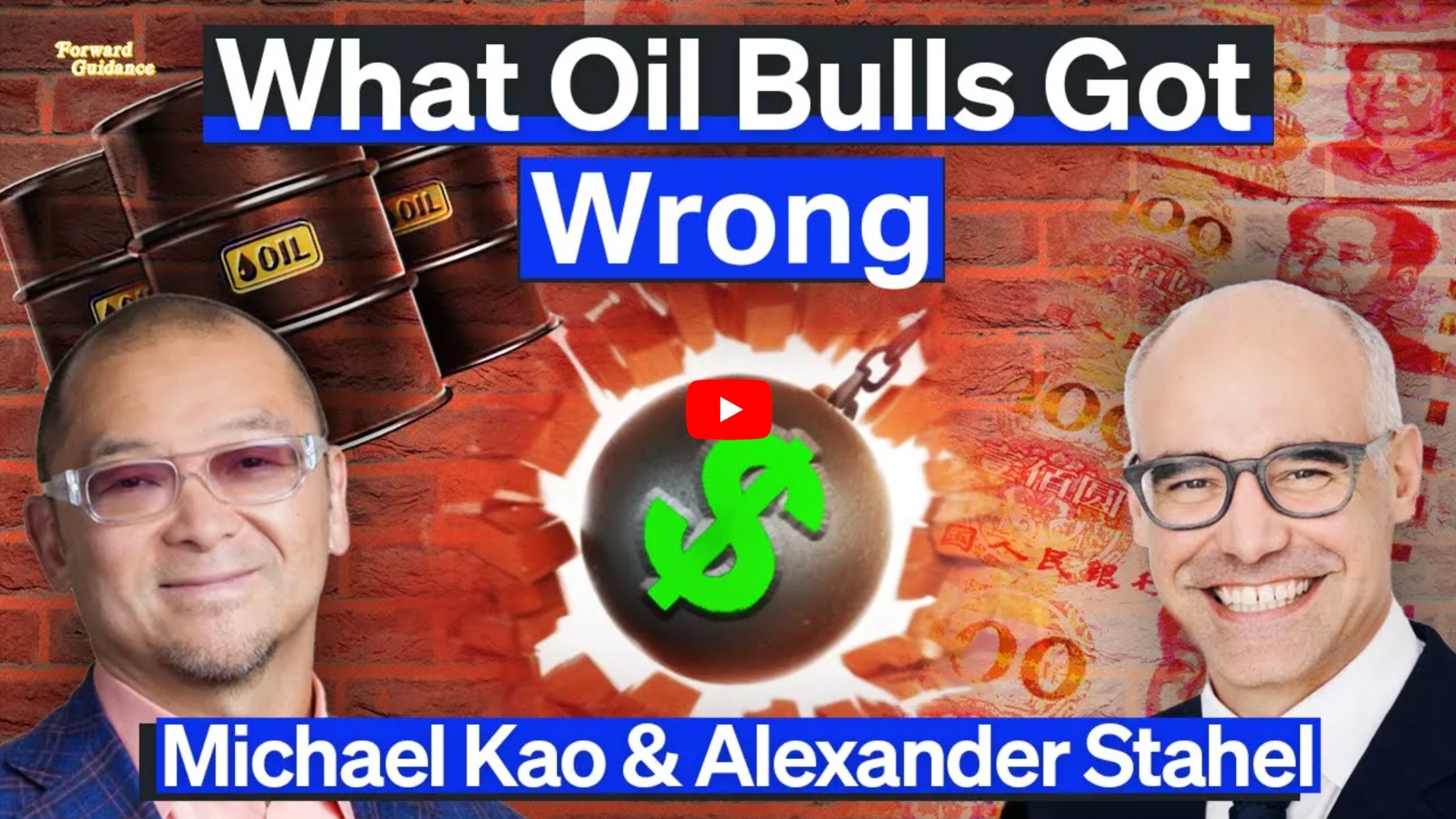Quick Summary
In this article, we delve into the intricate relationship between the Chinese yuan (CNY) and the oil market, exploring a phenomenon known as the Doom Loop. We are joined by Michael Cow, a private investor and former hedge fund manager, and Alexander Stahl, the founder and chief investment officer of Berg Robin Holding, who brings his expertise in commodities and oil. Both gentlemen have been bearish on the market, and we aim to understand if their perspective has changed.
The dynamics of spare capacity play a crucial role in the oil market, impacting price stability and market equilibrium. While spare capacity can provide a buffer during times of high demand or disruptions, its depletion can lead to price volatility. Understanding the intricate relationship between spare capacity, market dynamics, and geopolitical factors is essential for forecasting oil prices. As we navigate the complex oil market landscape, it is crucial to monitor spare capacity levels, OPEC’s actions, and the evolving energy landscape to gain insights into future price movements.
Skip to
Discussion Topics
Unraveling the Doom Loop
The Doom Loop, as explained by Michael Cow, refers to a positively reinforcing feedback loop that affects the Chinese economy and its currency, the CNY. Michael draws inspiration from Greek mythology, specifically the tale of Odysseus navigating between two monsters. In this analogy, the weak CNY represents Scylla, while the strong CNY represents Charybdis.
Historically, a weak CNY posed a threat to China’s economy due to the country’s heavy reliance on oil imports, which are denominated in US dollars. The risk was intensified when both oil prices and the dollar were on the rise, leading to a double whammy of inflationary pressure. To avoid this, China faced the conundrum of balancing a weak CNY and a strong CNY.
The Impact of COVID-19 on China’s Response
The COVID-19 pandemic added a new layer of complexity to China’s economic situation. Unlike Western countries, China responded with limited consumer support and a prolonged lockdown period. As a result, the Chinese consumer base was significantly affected, leading to reduced spending and limited travel. Despite anecdotes of wealthy individuals spending lavishly, the data did not reflect this behavior.
The Role of Commodity Prices and Demand for Oil
With the decrease in commodity prices, the fear of importing dollar-based inflation subsided. However, China’s heavy reliance on export growth and lack of internal consumer support presented challenges. To stimulate the economy and break the Doom Loop, China needed a powerful stimulus and had to contend with the policies of the US Federal Reserve (Fed) and the European Central Bank (ECB), which were focused on combating inflation.
Assessing the Oil Market: A Bearish Perspective
Both Michael and Alexander took a bearish stance on the oil market, starting approximately a year ago when oil prices were at $120 per barrel (Brent). Several factors contributed to their skepticism:
- Changing Dynamics: The oil market experienced a shift from a long-cycle project era to one that incorporated US shale oil production, significantly altering the supply landscape.
- Sanctions and Supply Concerns: Discussions surrounding European sanctions on Russia raised concerns about the availability of Russian oil exports. Uncertainty loomed over the replacement markets and transportation logistics.
- Weakness in Demand: European and Asian markets displayed signs of weakened demand, with Europe facing gas and power crises and China undergoing COVID-19-related lockdowns. The US was the only region showing relatively stronger demand, but it was still affected by high prices.
- Oversupply and Overestimation: Expectations of demand destruction due to high prices were overestimated, while oversupply emerged from unexpected sources like Iran and Argentina.
The Unfolding of Supply and Demand Dynamics
Contrary to earlier predictions, Russia managed to maintain its crude oil supply despite the sanctions. In fact, it even increased its export volume by accepting lower prices. Additionally, other countries such as Iran, Argentina, and Mexico surprised the market with unexpected increases in supply. On the demand side, the chemical sector faced challenges, leading to a collapse in crack spreads. Diesel demand weakened globally, including in the US and Europe, due to factors such as consolidation in the industry and behavioral shifts.
Understanding Forward Curve Signals
The discussion highlights the limitations of using current forward prices as reliable indicators of future spot prices. However, one signal known as the \”c2b flip,\” where contango flips to backwardation, has shown some predictive power. Backwardation, indicating that current oil prices are higher than future prices, suggests a convenience yield for spot commodities. This signal was present at the beginning of 2021, leading to a bullish outlook at the time. However, no comparable predictive indicator exists for the opposite scenario, as backwardation flipping to contango occurs too late to act upon.
Evolving Bearish Sentiment
Considering the updated supply and demand dynamics, Alexander expresses a slightly more bearish perspective than before. Supply surprises to the upside have been observed in several countries, while demand issues persist. Crack spreads and diesel demand remain weak, affecting different regions. The complexities of forecasting oil demand lie in the coincidental and lagging nature of demand metrics, making it challenging to predict shifts accurately.
The Importance of Spare Capacity
Spare capacity refers to the amount of oil production that can be quickly brought online to meet any sudden increase in demand or supply disruptions. It serves as a buffer to stabilize oil prices and ensure market stability. When spare capacity is high, there is a sense of security in the market as there is enough supply to meet any unexpected events. However, when spare capacity is low, it can lead to price volatility and market uncertainty.
OPEC’s Historical Role in Managing Spare Capacity
OPEC, the Organization of the Petroleum Exporting Countries, has traditionally played a significant role in managing spare capacity and balancing the oil market. In the past, OPEC’s spare capacity was often utilized to offset any production shortfalls or disruptions from other oil-producing countries. This allowed OPEC to increase or decrease its oil production to stabilize prices and maintain market equilibrium.
The Changing Dynamics of Spare Capacity
In recent years, the dynamics of spare capacity have been evolving due to various factors. The run-up to 2021 and 2022 saw OPEC playing a crucial role in balancing the market as certain countries, like the United States, were recovering from the COVID-19 pandemic and not producing at their full capacity. However, as these countries ramped up production, OPEC’s spare capacity decreased, leading to potential concerns in the market.
The Relationship between Spare Capacity and Oil Prices
When spare capacity reaches critically low levels, it can trigger a bull market in oil prices. This occurs when there is no more spare capacity available from any of the OPEC members, leading to concerns about the future supply of oil. As a result, prices need to increase significantly to balance supply and demand. However, it is important to note that prices rising due to limited spare capacity are not sustainable in the long term.
The Complexity of Oil Price Forecasts
Forecasting oil prices is a challenging task, and various factors come into play. The current market conditions, geopolitical events, supply-demand dynamics, and spare capacity all influence the direction of oil prices. While some analysts argue that lower spare capacity could lead to a significant price decline, others believe that factors like stimulus measures and the China reopening could support prices in the short term.
The Impact of China and the Strategic Petroleum Reserve
China, as one of the world’s largest consumers of oil, plays a vital role in the oil market. Its strategic petroleum reserve (SPR) and oil demand can have a considerable impact on prices. Additionally, the United States, with its strategic petroleum reserve and growing energy independence, has a different market dynamic. The U.S. has become less reliant on oil imports and has the ability to optimize refinery margins through trade.
The Risk of OPEC+ Harmony and Compliance
Maintaining harmony among OPEC members and ensuring compliance with production cuts are ongoing challenges. While Saudi Arabia, as a major producer, has shown discipline and leadership, other members have been non-compliant in the past. This lack of unity can create uncertainty in the market and affect OPEC’s ability to manage spare capacity effectively.
The Future of Oil Prices
Looking ahead, the future of oil prices is uncertain. We are currently in a period of driving season, which may temporarily support prices. However, the weakening global demand and the potential need for OPEC to implement further production cuts could put downward pressure on prices. Additionally, market liquidity, correlation events, and the actions of key market players can influence oil prices.
Why Watch?
The decline in Russia’s arms exports and delays in production have raised concerns about the quality and competitiveness of Russian weapons, which has begun to expand into a larger economic challenge for the entire country. The significant increases to military spend have been compounded by the reduction in demand for Russian weapons in making warfare unprofitable and potentially destabilizing for Vladamir Putin and the Russian military. Joe Blog’s explains many of these nuances, along with other international variables and players involved with the international arms trade. He also offers his own insight on economic trends that are currently in flux within the global arms trade, specifically as it relates to Russian and US weapon sales to African countries.
Highlights
Rabbit Holes
Dig deeper into the people, places, and self-interests from this video that are pushing the world economic system to the brink:
- China,Chinese Yuan,Inflation,Oil,Recession,Russia,US Dollar

